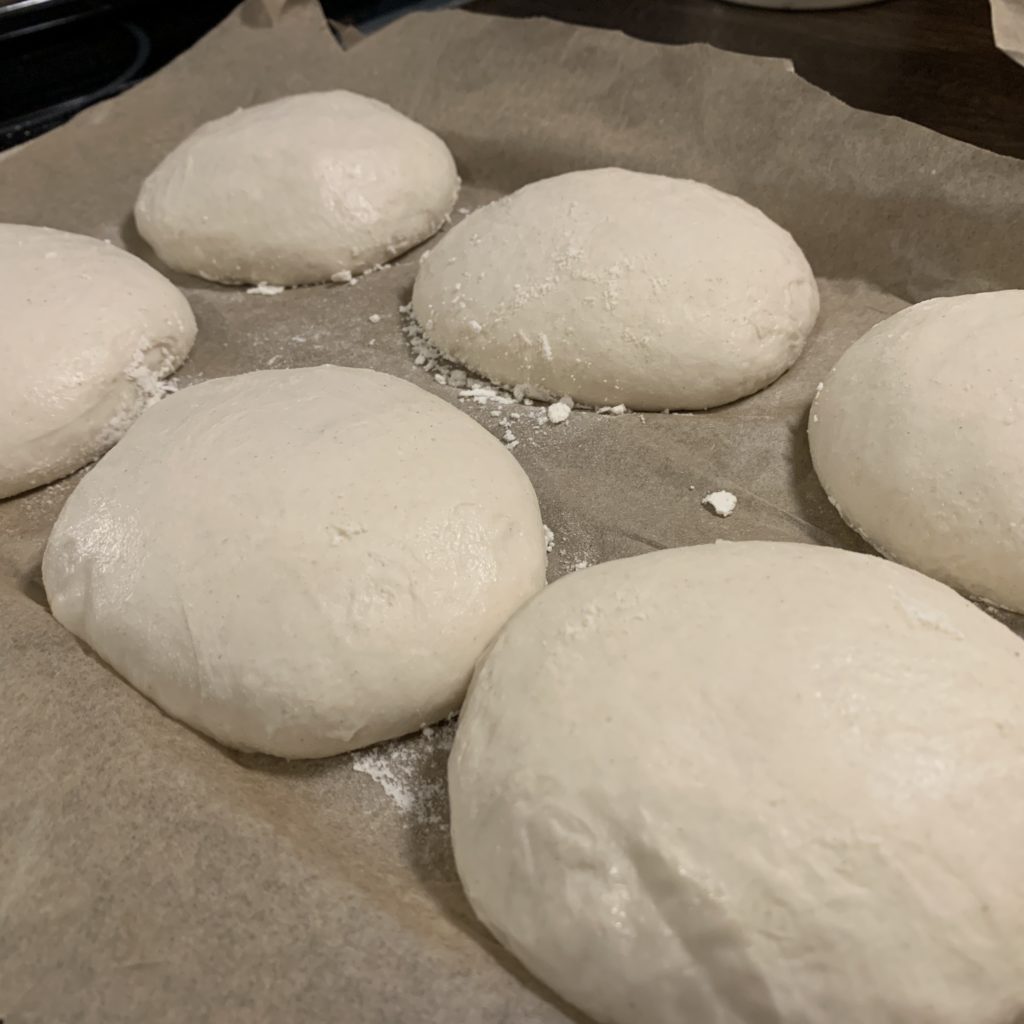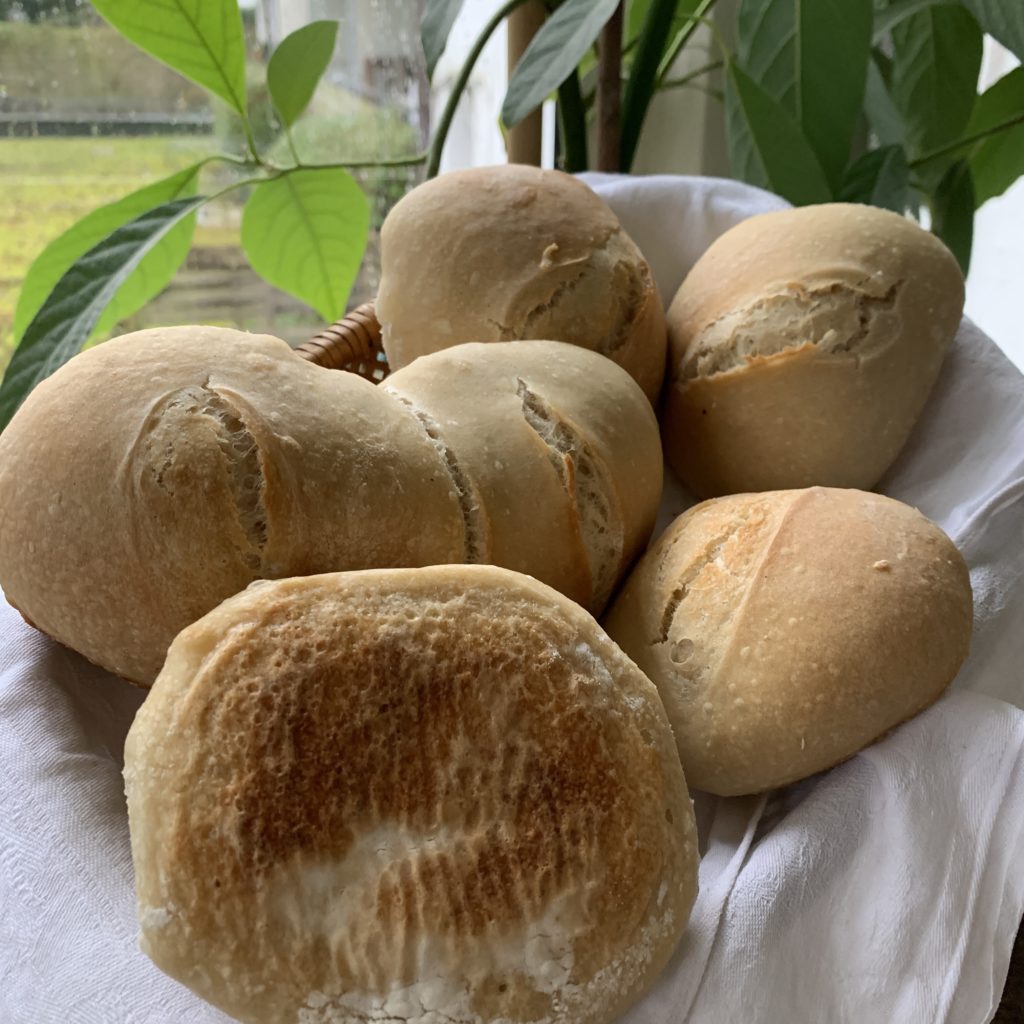Hmmmm, fresh sourdough rolls! For BB Tina 8 ❤️
If you've ever baked rolls with sourdough, you know how time-consuming it is because the dough has to rise twice. Fortunately, there are quite a few recipes that have the leavening cold overnight, so that you only have to let the finished dough warm up in the morning and then you can immediately form the rolls. However, the then still have to rise... the rolls won't be ready under 2 hours.
This is certainly not the right thing to do on Sunday mornings with hungry children. That's why these rolls don't use the stock, but the individual proofing overnight, so that the rolls are on the table fresh and warm after less than an hour. They are also very good cooled down, which is why I sometimes bake twice as much and make sandwiches from the leftover rolls for a picnic in the afternoon.
INGREDIENTS
- 500 gr. wheat flour
- 335 gr. lukewarm water
- 80 gr. Lievito Madre *
- 7 gr. fresh yeast
- 15 gr. salt
- 13 gr. butter
- 13 gr. honey
* The Lievito Madre must be freshly fed over 2 days, so that she has enough strength to manage with the low addition of yeast. Thus, the rolls succeed even for sourdough beginners. If you don't have wheat sourdough (yet), you can take 10 gr. of fresh yeast instead. Or you make yourself a quick Lievito Madre, takes only a good week.
PREPARATION
Day 1, morning / noon. First, make an autolysis dough from the flour with the water and leave it covered for 30 minutes.
What is autolysis dough?
An autolysis dough is a zero dough made of flour and water. Both are simply mixed, not kneaded, and left to rest for at least 30 minutes. The resting time here takes over part of the kneading time, because starch and protein combine to form a stable adhesive structure. Autolysis has a positive effect on the volume of the pastry and ensures a crispier crust (Source: Johannes Hirth & Jörg Schmid: Wildbakers - Of two who set out to bake the perfect bread).
After the dough has rested for 30 minutes, add the remaining ingredients and knead with a food processor or a hand mixer with dough hook for about 3 minutes on low speed and 5 minutes on maximum speed. Let the dough stand, covered, until it has doubled in volume. This depends on the room temperature, air flow, and how active your sourdough is. You should allow at least 6 hours. With more added yeast, of course, it will go faster than with less.
Day 1, afternoon / evening. When the dough has risen well, transfer it to a lightly floured work surface and form 6-8 rolls (depending on how big you like them). To do this, flatten the dough slightly and then begin to fold it inward from the sides. Continue doing this until you have a round piece of dough with a tangible tension. Turn the dough over and set it down with the folded edges facing down.
Forming bread rolls (video)
Line a flat, large container with a lid with baking paper and place the formed dough pieces in it. The dough pieces will rise, so need 1-2cm space to the sides. Close the lid and store in the refrigerator overnight.



Day 2, in the morning. The next morning, carefully lift the risen rolls out of the container with the baking paper and let them acclimatize for 30 minutes. Meanwhile, use the time to shower 😆 - and preheat the oven to 240°C top/bottom heat. Then, if desired, spray the dough with a little water and sprinkle with poppy seeds or flour. Cut at least once in the middle with a very sharp knife.
Bake the rolls in the lower third of the hot oven with steam. To do this, either place a bowl with 200 ml of water in the bottom of the oven when heating up, or steam with 1-2 sprays from a water bottle when sliding the tray in. After 10 minutes, reduce the temperature to 220°C, open the oven door to let the steam escape and finish baking for another 10 minutes. Turn off the temperature and leave in the oven for another 5 minutes. Take them out and let them cool a bit so they are cooked through inside.
If you like a softer crust, just bake the rolls without steam.

Liebe Katsu,
geht dieses Rezept auch mit einem Roggensauer? Ich habe heute Anstellgut geschenkt bekommen und würde gern Sonntagsbrötchen backen.
Bzw: Ich liebe diese Seite und deine Rezepte! Mein erstes Fermentationsprojekt ging total daneben, denn da hatte ich deine Infos noch nicht entdeckt 😉
Danke und liebe Grüße
Papagena
Liebe Papagena,
ich freue mich sehr, dass Dir meine Seite so gut gefällt und vorallem, dass sie hilfreich ist. Danke 🧡
Die Brötchen habe ich selber noch nicht mit Roggensauer probiert, aber es müsste funktionieren. Bei Roggensauer würde ich die Stockgare über Nacht führen und die Brötchen erst morgens formen. Du kannst sie beobachten, eventuell sind sie nach 30 Minuten schon backfertig, sonst 60 Minuten abwarten. Und ich empfehle, trotzdem einen Weizenmehlanteil dazu zu nehmen.
Gutes Gelingen, und ich würde mich über einen Erfolgsbericht freuen!
Best regards,
Katsu
Liebe Katsu,
danke für deine Antwort! Die Brötchen sind für den ersten Versuch ganz gut geworden! Ich habe 250 gr Weizenvollkornmehr und 250 gr Dinkelmehl verwendet. Ist mit “Hefe” in deinem Rezept Trockenhefe gemeint? Ich hatte jedenfalls keine frische da. Aufgrund des hohen Dinkelanteils sind sie wahrscheinlich nicht so schön aufgegangen.
Ich habe bei Instagram gesehen, dass ich dich zu Roggenbrötchen inspiriert habe. Das freut mich! Ich würde mich wahnsinnig über dein Rezept freuen 🙂
Viele Grüße
Papagena
Liebe Papagena,
danke für Dein Feedback ❤️
Ich meine tatsächlich immer frische Hefe, wenn ich Hefe schreibe, habe aber jetzt die Angabe im Rezept präzisiert. Wenn Du 8 gr. Trockenhefe genommen hast, hätten die Brötchen eigentlich abgehen sollen wie Luzi. Mag sein, dass das nicht so war wegen des Dinkelmehls. Das weiss ich aber nur in der Theorie, weil ich kein Dinkelmehl benutze aufgrund des hohen Glutengehaltes.
Ich kann Dir gar nicht genug danken, dass Du mich auf Roggen gebracht hast, weil ich jetzt weiss, wie KÖSTLICH frisch gebackene Roggenbrötchen sein können. Das Rezept schreibe ich auf jeden Fall auf. Wenn Du mir auf instagram folgst, bekommst Du es ja sofort mit 😊
Liebe Grüsse und noch viel Freude beim Backen,
Katsu
Hallo liebe Katsu,
was meinst du genau mit “Der Lievito Madre muss über 2 Tage frisch gefüttert sein”: innerhalb der letzten 2 Tage einmal füttern, oder 2x füttern in 2 Tagen?
Danke und viele Grüße!
Hej Anke,
an zwei Tagen füttern, damit er wieder in Fahrt kommt.
Gutes Gelingen!
Katsu
Liebe Katsu,
inzwischen (und mit einem neuen Herd 😉 gelingen die Brötchen hervorragend und wir alle lieben sie! Frage: kann man die Hefe auch ganz weglassen und nur mit LM (Olga) machen?
Hej Anke, das freut mich!
Ja, wenn Olga sehr aktiv ist, kannst Du die Hefe auch weglassen.
Bon appétit!
Katsu
Liebe Katsu,
du schreibst in deiner Anleitung zur “Mutter”, dass das Füttern ca. 8 – 10 Std. in Anspruch nimmt. Kann ich dann einmal morgens und einmal abends (dann über Nacht) füttern und morgens dann den Teig für die Brötchen ansetzen? Oder muss das zwingend an zwei Tagen passieren?
LG, Angela
Hej Angela,
ich bin mir nicht ganz sicher, ob ich deine Frage verstehe. Du kannst die Mutter über Nacht auffrischen und am nächsten Morgen den Teig ansetzen. Die rundgewirkten Brötchen müssen dann noch eine Nacht gehen/garen.
Hilft dir das?
Katsu